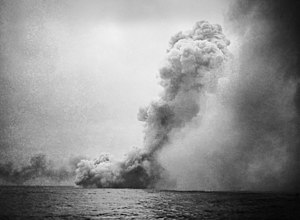Battle of Blenheim Bay
| Battle of Blenheim Bay | |||||||
|---|---|---|---|---|---|---|---|
| Part of the Continental War | |||||||
 MCS Treue exploding after shelling | |||||||
| |||||||
| Belligerents | |||||||
|
|
| ||||||
| Commanders and leaders | |||||||
|
| |||||||
| Strength | |||||||
Total: 131 combat ships
| |||||||
| Casualties and losses | |||||||
|
| ||||||
The Battle of Blenheim Bay (Hesurian: Pereuthschlacht; Battle of Pereuth) was a major naval battle that occurred at Blenheim Bay, north of the Mascyllary port city of Pereuth, between the Kingdom of Hytekojuznia Navy, under Admiral Germund S. Halberscham, and the Mascyllary Navy, under X. The battle was the largest and last battle ever fought by steel battleships and resulted in the Grand Blockade of Mascylla which severely limited Mascyllary imports, particularly that of oil for tanks. However, the victory came too late for Hytekojuznia and Mascylla had advanced far enough by the time of the battle that they were able to inflict defeat upon Hytekojuznia.
The Hytekojuznik Navy had seen limited activity during the war until Blenheim Bay, and only minor scuffles with stray Mascyllary ships had been recorded. The Hytekojuznik Navy's main task of the war was to prevent shipping from reaching Mascylla to limit their ability to fight during the war. It had mainly tackled civilian ships and small-scale ship landings. While Mascylla was certainly a naval power in its own right, it lacked the numbers - and to a degree, the experience - to engage the entire Hytekojuznik fleet. As such, Mascylla spent the first five years of the war attempting to lure the Hytekojuznik fleet into Mascyllary naval flanking traps, but were unable to succeed. In 1915, plans were drafted in Hytekojuznia that required the navy to force a decisive defeat on the Mascyllary naval forces by the end of the year in an attempt to prevent oil from reaching the country outright. This was done to try to limit the amount of tanks Mascylla could field at once, which were inflicting defeat after defeat on the Hytekojuznik forces in Mascylla, who found no way to counter them. Separate fleets of the Hytekojuznik Navy were merged into the Royal Fleet on May 7 under Admiral Germund S. Halberscham and Vice-Admiral Helmut Kiesling. They formed more effective formations to trap the faster Mascyllary ships and successfully trialled the formation on May 11.
On the morning of May 15, the Royal Fleet began its search for the Mascyllary fleet, bringing the battle to the Mascyllary who would have almost certainly expected the Hytekojuzniks to take defensive stances based on the success Mascylla was facing on land. They enforced a stronger blockade just north of Lielosta to all civilian shipping to Mascylla. Mascyllary Admiral X was made aware of the blockade on May 20, and ordered many smaller fleets to attempt to fire shots to disperse the fleets, which, due to the spread out blockade, worked initially. However, on May 26, Halberscham had desisted the blockade and concentrated all his forces into one dense fleet, practising the trialled formations. A small Mascyllary fleet of around ten ships, led by 1912-built battlecruiser MCS Treue, were surprised by the 131-ship strong Royal Fleet, and the beginning of the battle was marked by the sinking of the Treue, reportedly only three minutes into the combat. Over the next four days, the Mascyllary fleets would attempt to reinforce the fleet from the sides by flanking the Royal Fleet, but the formations had accounted for Mascyllary flanks and dealt with them effectively.
By the end of the battle on May 30, Mascylla had felt the blow of one of the heaviest naval defeats in history, with 60 ships sunk in total, over half of the initial fleet. In total, 5,312 were killed, 740 wounded and 210 captured (all Mascyllary sailors captured by Hytekojuznia), with 80 ships sunk between both navies, 75% of which were Mascyllary ships. The Hytekojuznik High Command were ecstatic with the victory at Blenheim Bay, and instituted the Grand Blockade the next day, blockading many major Mascyllary coastal cities. Halberscham and Kiesling were hailed as heroes back in Hytekojuznia and were awarded with highest naval honours. Despite the victory, it came too late in the war to turn the tide of the conflict completely, and Mascyllary ended up emerging victorious in 1916.
The battle is considered one of the most significant in history, and dealt such a heavy blow to Mascylla that its navy wouldn't recover under well after the Mascyllary Revolution. Hytekojuznia's Navy was forcefully scrapped as part of the Treaty of Sigairen in 1916, despite the vocal disdain from the Hytekojuznik diplomats. Halberscham's formation, tactics and performance at Blenheim Bay were enough to get him revered as one of the pioneers of modern naval strategies, and a statue of him stands outside of the Lielosta Naval Institute, the largest in the country.